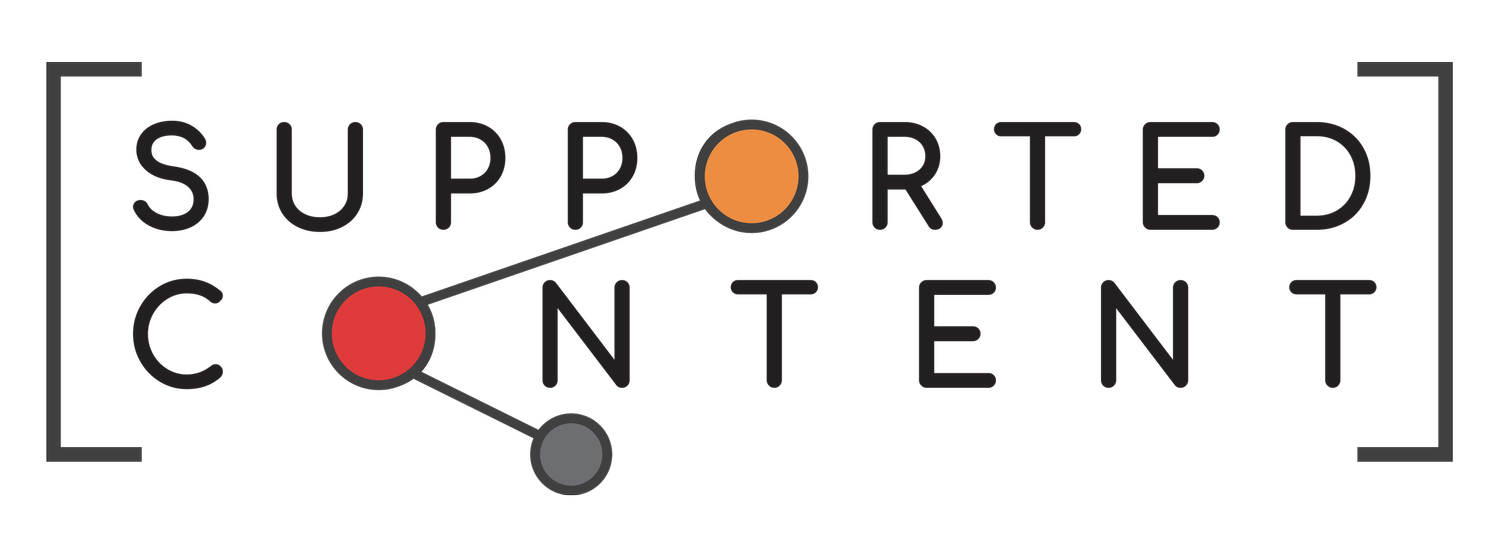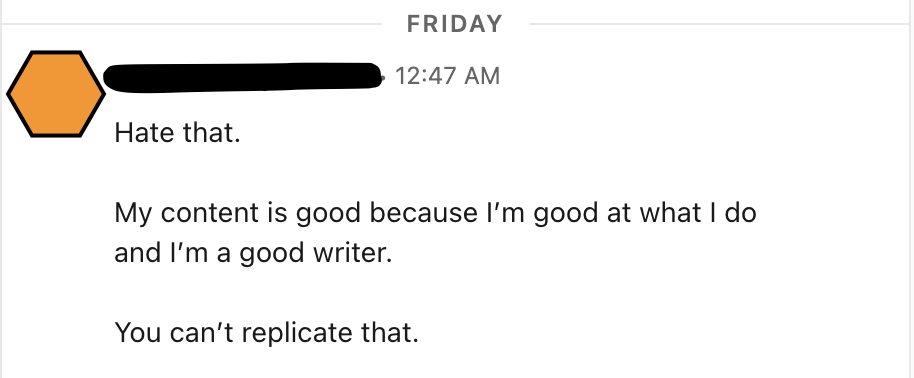Why founders aren’t publishing online consistently (and what to do about it)
Adam Robinson (founder of Retention.com and RB2B) recently posted about the top 7 reasons people are afraid to start posing on LinkedIn.
Here’s his list:
You can’t be authentic.
You can’t play the long game.
You’re afraid of the people who will hate you.
You’re in denial about outbound.
You’re afraid of how hard it is to be great.
You’re afraid of the time commitment.
You feel like you’re too far behind.
Here at Supported Content, we help founders — mostly of CX brands, but also in the broader SaaS space — publish consistently on LinkedIn through ghostwriting for them.
Given that experience, Adam’s post made me pause and ask: "Are these the same reasons we’re seeing?”
Why most founders and execs aren’t active on LinkedIn
I talk to prospective ghostwriting clients regularly.
They’re typically founders or execs of B2B companies, usually fairly early-stage. Some are bootstrapped, others are VC-backed.
The fact that these folks are willing to hop on Zoom with me and chat about ghostwriting means they realize there’s potential value in posting regularly.
Sometimes, they even feel guilty about not posting. In one recent call, a CEO said, “I see a couple of my peers posting all the time and getting invited to podcasts, and I realize that I probably should be doing that too.”
I agree with most of Adam’s 7 points why people aren’t publishing, but in my conversations with founders I’ve found there are three big reasons why they don’t do it:
They're busy.
They don't know where to start.
They're not sure if it will drive results for their business.
These are brilliant, capable, accomplished people. They have decades of stories, learnings, and insights to share.
And yet they’re feeling paralyzed by the idea of posting regularly online.
In most situations, these business leaders don’t need a lot of convincing on the potential value of posting. They need a guide who can help them make it happen.
Where (and how) using a ghostwriter helps founders
Ghostwriting gets a bad rap sometimes.
Exhibit A:
This was from an experienced founder (15+ years) who has created a lot of good resources for customers, but has only posted 3 times in the last year. He asked what we did, I mentioned ghostwriting, and he reacted strongly.
Here’s the problem: Most people hear “I ghostwrite for founders” as “I’m going to pretend to be you.”
That’s wrong, unhelpful, and frankly, dishonest.
A good ghostwriter is a thought partner, a communication coach, an accountability partner…and sometimes a therapist (clients like to vent, which is cool by me). The key to ghostwriting is asking good questions, listening, and not being afraid to push deeper. Writing comes second.
Let’s tackle the three reasons I shared above in order.
Founders don’t post because they’re too busy
Good writing takes time, especially when you’re starting from a blank page. Founders and execs have incredibly full plates, and the likelihood of getting them to sit down for several hours each week to write content it…well, let’s just say unlikely.
A ghostwriter solves this at multiple levels:
They kill blank page syndrome. I do a biweekly content interview with each of our clients. These interviews generate >90% of their LinkedIn content. But we’re not just sitting on those calls hoping lightning will strike. Before each call, I do a lot of prep work and create questions to give us a running start.
They remove most of the time requirement. When we ghostwrite for founders, they make two commitments:
To show up for our biweekly interviews. These are each about 60 minutes.
To review the content before it’s scheduled to post. This typically takes another 30 minutes every 2 weeks.
That’s about 3 hours of work a month, opposed to several hours each week (at minimum).
2. Founders don’t know where to start with posting
I hit on the challenge of blank syndrome above, so I won’t repeat myself here.
Here’s the major point: Publishing on LinkedIn (or any other platform) includes a lot of moving parts. Sure, anyone can just throw something out there…but if you want to build your brand, build trust with prospects and customers, and attract potential partners and investors, then you need a more strategic approach.
When we ghostwriter for founders, we:
Walk through a brief onboarding and content strategy session to get clear on who their ideal audience is and what they want to talk about
Audit and optimize their profile (including creating lead magnets, if needed)
Experiment to find the right mix of content and topics
Dial in the hooks for each post so that people actually read and engage with them
Make sure posts are formatted in a way that works (and this is constantly changing)
Confirm the reading grade level is appropriate (usually ~4th grade, which is hard to do)
Analyze results each month to figure out what’s working and where we should double down.
See the difference?
Trying to do all of this when you’re already short on time and when you don’t know all the pieces is an exercise in futility. That’s where a ghostwriter can function as your guide and coach — we make sure your efforts get results.
Speaking of results…
3. Founders aren’t sure if publishing online will drive results for their business
With any investment (of time or money), you want to make sure you’re going to get an ROI.
That makes sense.
But how do you figure out the ROI of publishing on LinkedIn?
It’s not like using Facebook or Google Ads — you can’t just say “We spent $5k and generated $10k in leads.”
Publishing consistently on LinkedIn does three four big things for you and your company:
It’s relationship building at scale. People don’t want to hear from brands, they want to hear from and connect with people. It’s true for prospects, customers, partners, investors…anyone. Your personal profile will always get better results than your company page.
It puts your expertise on display. People want to work with experts. They want to work with the folks at the forefront of their fields; the folks who know what they’re doing. They don’t know you’re one of those people unless you make it impossible for them to miss by consistently sharing lessons/insights/tips/stories.
It drives lead gen and nurturing. Because you’re showing your expertise and building relationships, you’ll naturally attract inbound leads over time. More importantly, any leads your business gets — inbound or outbound — will be warmer from having seen your content and feeling connected to you, leading to higher conversion rates. But, again,
It unlocks content repurposing. In the B2B space, your goal isn’t to go viral or drive up vanity metrics. It’s to start conversations, build trust, and overcome objections. When you publish consistently, you’re doing that at scale. An you can take the content that resonates most and give it to your sales team for following up with prospects, your marketing team to expand into blog posts or lead magnets, and more.
Here’s the big takeaway: While we can track numbers like engagement, audience growth, and impressions, a ghostwriter can never guarantee you specific targets or milestones. It’s not about vanity metrics.
The value you're getting by writing online is building trust at scale. You know it’s working when in 2-3 months you walk into a meeting with a potential investor or customer and they tell you how much they enjoyed your last post — you’ve already established a connection with them before you stepped into the room.
That’s priceless.
Start publishing today (or you genuinely might regret it)
Do you have to use a ghostwriter to publish great content and see results for your business?
No, absolutely not.
But if you believe that consistently publishing on LinkedIn (or other platforms) will bring good results for your business, then you do need to get started ASAP.
And if you’re struggling to get started because you don’t have enough time, you’re not sure where to start, or you’re unclear on how to get the best results, a ghostwriter can help overcome all three of those challenges.
I’d be happy to share more about our process and how we make publishing consistently easy for founders and execs — contact me here or shoot me a message on LinkedIn if you’d like to learn more!

